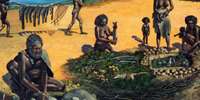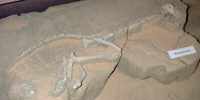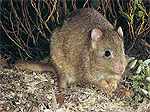Back to Don's Maps
 Back to Animals of Lake Mungo
Back to Animals of Lake MungoThe Mungo Burrowing Bettong
 Skeleton of a burrowing bettong. The burrowing bettong is now extinct on the mainland, and survives only on offshore islands where it is protected by isolation from predators such as foxes and dingoes.
Skeleton of a burrowing bettong. The burrowing bettong is now extinct on the mainland, and survives only on offshore islands where it is protected by isolation from predators such as foxes and dingoes.
The burrowing bettong is a nocturnal, vulnerable species. Both humans and predators are the main contributors to the decline of the burrowing bettong. The burrowing bettong now resides in Australia only on the islands of Barrow, Bernier, and Dorre off the coast of Western Australia. There are no natural predators on Barrow Island, and the population of burrowing bettongs on Barrow Island is about 5 000 animals, and this is the only secure population. 'Boodie' and 'Rat Kangaroo' are other common names for the burrowing bettong. There are efforts being made to bring the species onto the mainland of Australia.
Underground warrens are built by the burrowing bettong for shelter during the day. Notably, the burrowing bettong is the only macropod to use warrens. Upwards of 50 burrowing bettongs will live in the same warrens. This species is extremely social and communicates vocally using grunts, hisses, and squeaks. A single warren may have several entrances, nests are built of grass. Warrens can be found in scrub and hummock grasslands, preferring to dig under firm soil.
Text: http://www.australianfauna.com/burrowingbettong.php
Display: NPWS centre, Lake Mungo NP.
Photo: Don Hitchcock 2005
 The average weight of the burrowing bettong is 1320 g. The average head and body measurement is 300 mm, the average tail measures 240 mm. Burrowing bettongs on Barrow Island are slightly smaller compared to those on Dorre and Bernier Islands. Thick dark golden fur covers the animal but is lighter on the underbelly. Short ears and nose are present. The tip of the burrowing bettong always has black on the bottom half of the tail, however the very tip is sometimes white.
The average weight of the burrowing bettong is 1320 g. The average head and body measurement is 300 mm, the average tail measures 240 mm. Burrowing bettongs on Barrow Island are slightly smaller compared to those on Dorre and Bernier Islands. Thick dark golden fur covers the animal but is lighter on the underbelly. Short ears and nose are present. The tip of the burrowing bettong always has black on the bottom half of the tail, however the very tip is sometimes white.
Burrowing bettongs are largely vegetarian and will dig for food using scent to guide them to the food. This species enjoys eating leaves, fruit (particularly figs, they will build their warren under a fig tree if possible), fungi, and occasionally tubers and carrion found on the beach. Burrowing bettongs have been seen looking for food in human inhabited camps.
Male burrowing bettongs are highly aggressive. Breeding will occur throughout the year. The gestation period for this species generally lasts 21 days. Young will leave the pouch after 115 days. Young are born one at a time, a maximum of three young can be raised in one year.
Text: http://www.australianfauna.com/burrowingbettong.php
Photo of the burrowing inland bettong: http://thylacine-hunter.tripod.com/